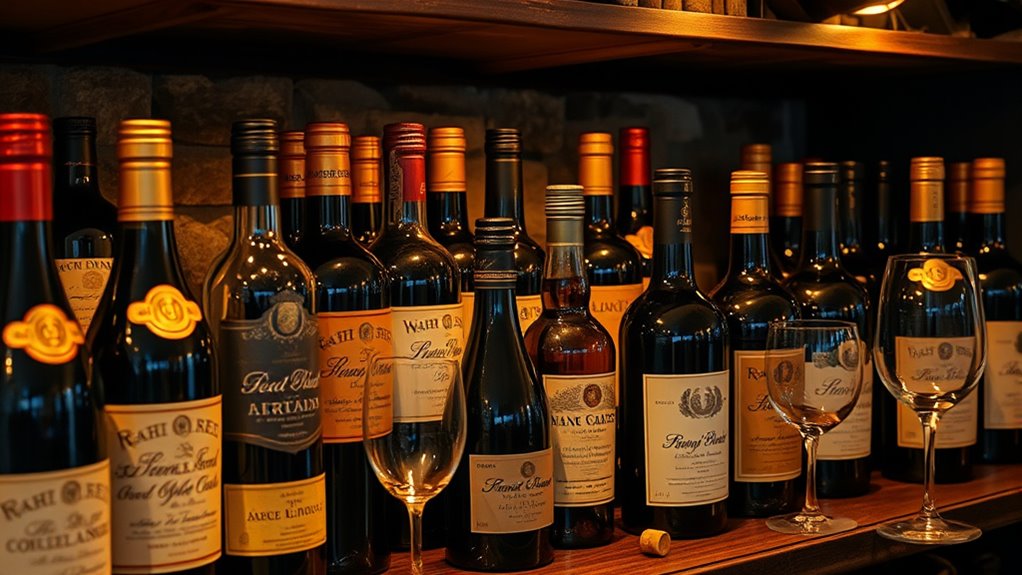To master the art of wine collecting, you need to understand different varieties, regions, and market trends. Set clear goals for your collection, focusing on quality, diversity, or investment. Store your bottles properly and organize them for easy access. Develop your palate through regular tasting and learn about provenance to protect your investment. By exploring sourcing, valuation, and selling strategies, you’ll refine your skills and create a meaningful collection—if you keep exploring, you’ll discover how to elevate your wine journey further.
Key Takeaways
- Define clear goals for personal enjoyment, investment, or a combination to guide collection strategy.
- Focus on reputable regions, varieties, vintages, and provenance to ensure quality and authenticity.
- Properly store and organize wines in climate-controlled environments to preserve value and facilitate access.
- Develop your palate through regular tasting, detailed notes, and comparisons to refine your preferences.
- Partner with experts and auction houses to buy, sell, and showcase your collection effectively.
Understanding Wine Varieties and Regions
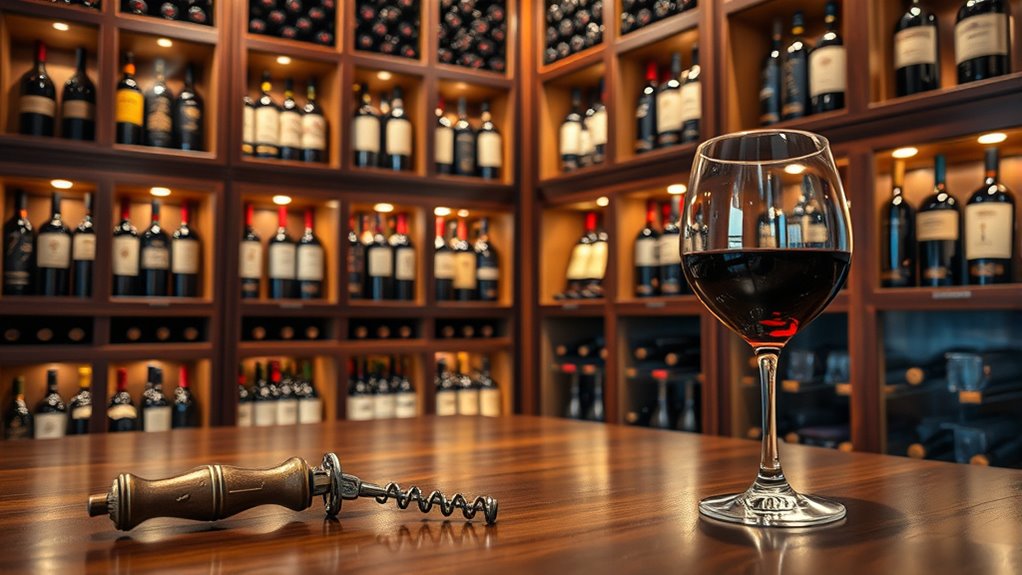
Have you ever wondered how different wine varieties and regions influence the flavors in your glass? Your choice of wine varieties, like Cabernet Sauvignon or Chardonnay, shapes the taste, aroma, and texture you experience. Each wine region, from Bordeaux to Napa Valley, offers distinct terroirs, climates, and styles that impact the wine’s character. Recognizing appellations helps you identify the origin, ensuring authenticity and quality. Local grape varieties, such as Sangiovese in Italy or Riesling in Germany, add regional uniqueness to wines. Vintage quality varies by year and location, affecting aging potential and value. Understanding wine regions can deepen your appreciation for the complexities behind each bottle’s profile. By understanding how wine varieties and regions intertwine, you gain insight into what makes each bottle unique and how to select wines that match your preferences. Asset division principles can also be applied when considering the division of valuable wine collections during estate settlement to ensure fair distribution. Appreciating terroir can deepen your appreciation for the complexities behind each bottle’s profile. Additionally, gaining knowledge about vintage quality can help you select wines with better aging potential and value over time.
Setting Goals for Your Collection
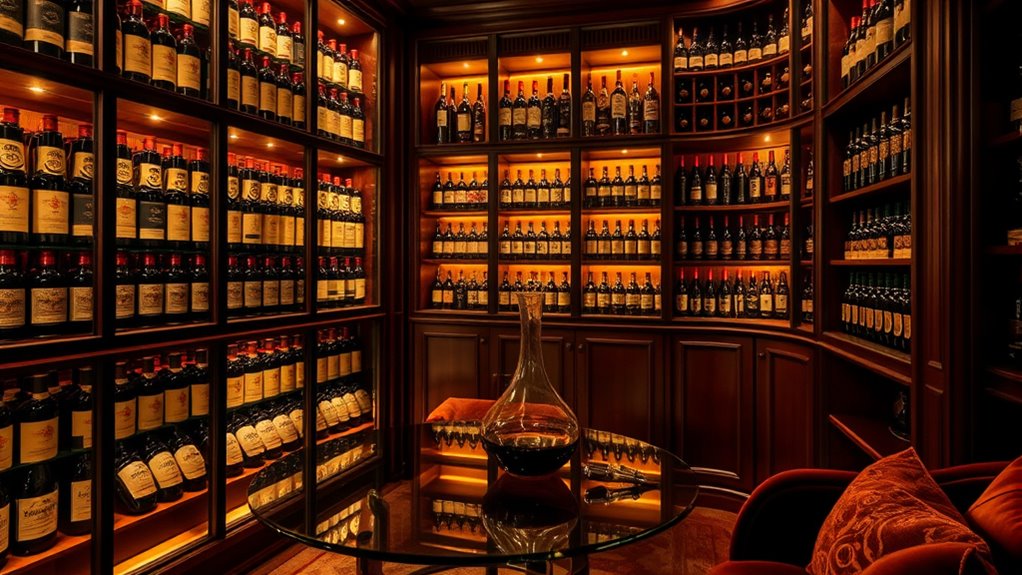
Establishing clear goals is essential to building a focused and satisfying wine collection. Your goals guide your collecting journey, ensuring you stay aligned with your desires and resources. Decide if your collection is for personal enjoyment, investment, or both, which influences your purchasing choices. Consider focusing on regional wines, grape varieties, or vintage periods to keep your collection cohesive. Use this table to set your goals:
| Goal Type | Focus Area | Key Questions |
|---|---|---|
| Personal enjoyment | Favorite regions | Which wines bring you joy? |
| Investment | Market trends | Which wines appreciate over time? |
| Variety | Diversity goals | How broad do you want your selection? |
| Budget | Spending limits | How much can you allocate per bottle? |
| Growth & review | Evolving tastes | When will you reassess your goals? |
Regularly review these goals to adapt to your tastes, market shifts, and collection progress.
Building a Curated Selection
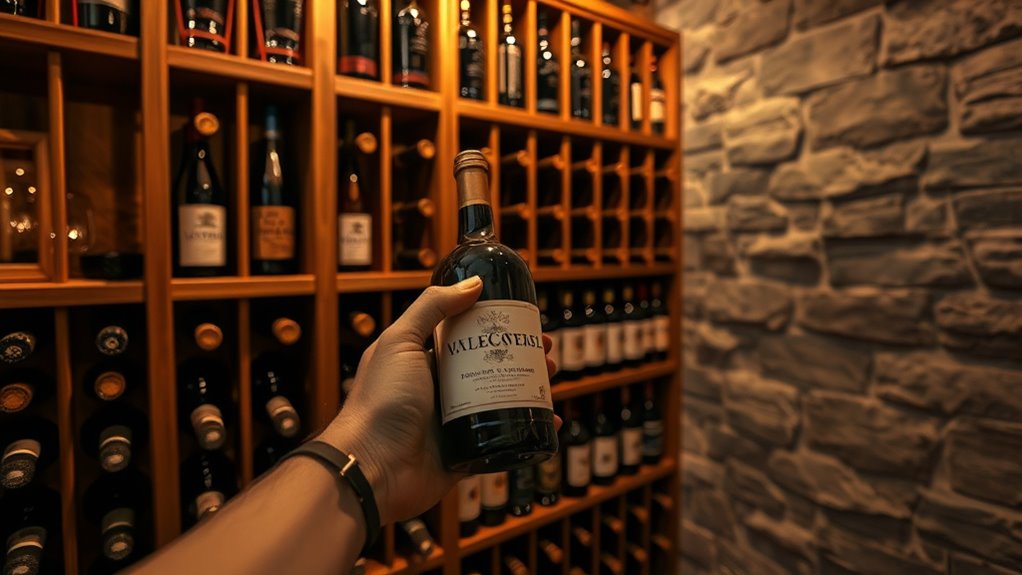
Building a curated wine selection means focusing on what truly appeals to you while maintaining balance. You should aim to include both rare, high-quality bottles and more affordable options for regular enjoyment. By intentionally combining variety and rarity, you create a collection that’s both enjoyable now and valuable over time. Incorporating economic principles can help optimize your choices for long-term satisfaction and investment potential. Additionally, understanding market trends can guide you in making informed decisions that enhance your collection’s value and relevance. Paying attention to supply and demand dynamics is essential for anticipating future market shifts that affect wine value. Recognizing consumer preferences can further refine your selections to match evolving tastes and trends.
Curate With Purpose
How can you guarantee your wine collection reflects your true passions and goals? The key is to curate with purpose. Focus your wine collection by selecting specific regions, grape varieties, or vintages that resonate with your personal taste and vision. Prioritize quality over quantity, choosing wines with excellent ratings, reputable producers, and aging potential to maximize long-term value. Think about thematic concepts, such as rare bottles or iconic vintages, to create a meaningful narrative within your collection. Regularly assess and refine your selection, removing bottles that no longer align with your goals. Maintain detailed records of provenance, tasting notes, and storage details. This disciplined approach embodies the art of wine, ensuring your collection remains intentional, inspiring, and uniquely yours. Incorporating best anime movies into your leisure time can also enrich your cultural appreciation, adding depth and variety to your personal interests. Embracing a personal growth mindset can further enhance your ability to develop a thoughtful and satisfying wine collection that truly reflects your evolving tastes. Additionally, understanding the long-term value of your bottles can guide smarter investment decisions, helping your collection grow in both quality and significance.
Balance Variety and Rarity
To create a truly engaging and versatile wine collection, you need to strike a balance between variety and rarity. This means including wines that showcase diversity across regions, grape varieties, and vintages, ensuring your collection remains well-rounded. Incorporate both popular, high-quality wines and rare, limited-edition bottles to boost the collection’s rarity and value. However, don’t overemphasize rarity, as it can limit variety and enjoyment. Make sure to add accessible, everyday wines for regular tasting, so you stay connected to your collection without risking your rarest bottles. Regularly reassess your selection to maintain an ideal mix, aligning with your evolving tastes and collecting goals. Achieving this balance will keep your collection dynamic, interesting, and rewarding. Additionally, understanding the art of espionage can help you discreetly gather insights about rare wines and market trends to refine your collection strategically. Developing market awareness is essential for making informed acquisitions and staying ahead in the competitive world of wine collecting. Being familiar with drivetrain components can also help you identify potential issues early, ensuring your collection remains in optimal condition over time. Proper storage conditions are crucial for preserving the quality and longevity of your wines, especially the rarer selections.
Optimal Storage and Organization Methods
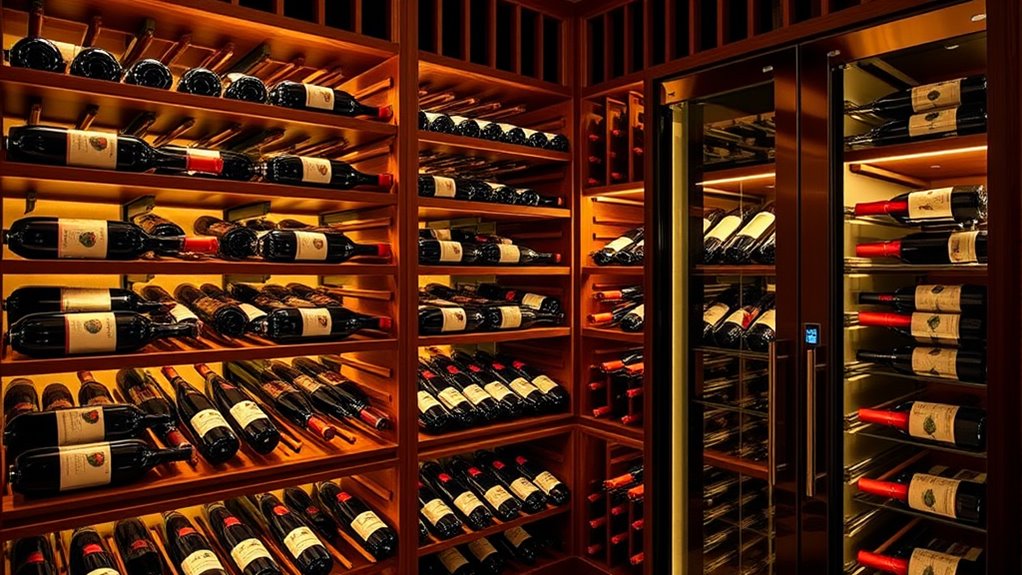
To keep your wine in top condition, you need to control both temperature and humidity carefully. Using a dedicated wine fridge or cellar helps maintain stable conditions and prevents spoilage. Organizing your bottles systematically makes it easy to find what you need and keeps your collection well-preserved. Incorporating wall organization systems can also enhance your storage space and add visual interest to your wine storage area. Additionally, considering climate control systems ensures consistent environmental conditions, which are crucial for preserving wine quality over time. Proper ventilation can also help prevent mold and maintain air quality within your storage environment. Implementing security measures can also protect your valuable collection from theft or damage.
Temperature and Humidity Control
Maintaining a consistent temperature and humidity level is essential for preserving your wine’s quality and aging potential. Proper temperature control keeps your wines stable, preventing spoilage, while ideal humidity levels (around 60-70%) protect corks from drying out and mold formation. Fluctuations cause expansion and contraction, risking cork damage and oxidation. To guarantee the best wine storage, avoid direct sunlight, heat sources, or humid areas like kitchens. Using a dedicated wine cellar, wine fridge, or climate-controlled space maintains these conditions effectively. Here’s a quick guide:
| Temperature Control | Humidity Levels | Impact on Wine Storage |
|---|---|---|
| Keeps wine stable | Prevents cork drying | Ensures proper sealing |
| Avoids spoilage | Reduces mold risk | Maintains flavor integrity |
| Prevents oxidation | Protects wine from damage | Extends aging potential |
| Consistent conditions | Ideal range (60-70%) | Preserves quality |
| Stable environment | Prevents expansion | Safeguards wine in storage |
A stable storage environment is crucial to prevent fluctuations that can compromise wine quality over time. Additionally, regularly monitoring air quality within your storage space can help prevent issues related to excess humidity or stale air, ensuring optimal conditions for aging. Implementing proper ventilation can further improve the overall health of your wine storage area. Proper air circulation helps maintain consistent conditions and prevents mold growth.
Systematic Inventory Management
Implementing systematic inventory management guarantees your wine collection remains organized and easily accessible. Use dedicated wine inventory software or spreadsheets to categorize bottles by region, vintage, producer, and storage location. This keeps your inventory manageable and helps locate bottles quickly. Store wines in a temperature-controlled environment between 10-14°C with consistent humidity levels to protect quality and aging potential. Organize bottles systematically, such as by varietal or vintage, to facilitate easy access and proper rotation for optimal drinking windows. Maintain detailed records for each wine, including purchase date, price, market value, and tasting notes, to track provenance and value over time. Regularly audit and update your inventory to identify missing bottles, assess aging progress, and plan future acquisitions or consumption efficiently. Additionally, understanding the essential storage conditions can significantly enhance the longevity and quality of your wine collection. Proper climate control is crucial for preserving wine integrity, as fluctuations in temperature and humidity can negatively impact aging.
Developing Your Palate Through Tasting

Regularly tasting a variety of wines is essential for developing your palate and discovering your preferences. As you explore different styles, focus on making detailed tasting notes that include aroma evaluation, flavor impressions, and finish. Swirling the wine releases aromatic compounds, helping you better assess its bouquet and complexity, which is crucial for palate development. Pay close attention to the wine’s appearance, aroma, taste, and aftertaste to improve your ability to identify subtle differences in flavor profiles, acidity, tannins, and balance. Comparing wines side-by-side sharpens your senses and highlights nuances you might overlook otherwise. Over time, keeping consistent tasting notes reveals how your palate evolves, guiding you toward more refined wine selections and enriching your overall tasting experience.
Expanding With Rare and Limited-Edition Wines

To expand your collection, you should focus on sourcing rare and limited-edition wines from trusted sources like auctions and winery releases. These bottles often appreciate in value and enhance your collection’s exclusivity. Just remember, proper provenance and storage are essential to maintain their authenticity and worth over time.
Sourcing Unique Bottles
Ever wonder how to find those rare, limited-edition wines that truly stand out in a collection? To source these exclusive bottles, focus on limited-edition releases from renowned wineries, which often sell only to members or through special channels. Attend wine auctions and events, where you can bid on rare bottles not available in stores. Building relationships with boutique producers and knowledgeable sommeliers can give you early access to pre-release or hard-to-find wines. Keep an eye on industry publications and subscription services that announce limited runs or special vintages before they hit the mainstream market. Don’t overlook wine merchant exclusives and collaborations, which often produce unique, collectible bottles in small quantities. These strategies help you uncover hidden gems and elevate your collection with truly unique wines.
Limited-Edition Value Growth
Limited-edition wines often appreciate considerably in value due to their scarcity and high demand among collectors. When you’re collecting, these wines stand out because their limited production drives market demand, pushing prices upward. Rare releases from renowned wineries, such as special vintages or commemorative bottles, can see their value increase by 50% or more within just a few years. To maximize growth, it’s essential to understand their provenance, production details, and how market trends influence scarcity-driven collectibles. Building a diverse portfolio that includes both well-known labels and exclusive releases can boost your long-term investment. The appreciation of limited-edition wines depends on factors like winery reputation, vintage quality, packaging, and overall market demand for rare and collectible bottles.
Authenticity and Provenance
Authenticity and provenance play a crucial role in maximizing the value of rare and limited-edition wines. When collecting, verifying provenance through detailed documentation and certificates of authenticity ensures you’re purchasing genuine bottles with a clear history. Reputable auction houses and trusted merchants provide provenance records that trace a wine’s journey from vineyard to sale, giving you confidence in its authenticity. Well-documented provenance reduces the risk of acquiring stolen, misrepresented, or compromised bottles, which is vital for protecting your investment. Rare wines like vintage Clos de Vougeot or limited-release Champagne often feature unique provenance details that increase their collectability and value. Prioritizing authenticity and provenance in your collecting process helps you build a curated, trustworthy collection of rare wines that can appreciate over time.
Navigating the Market and Provenance
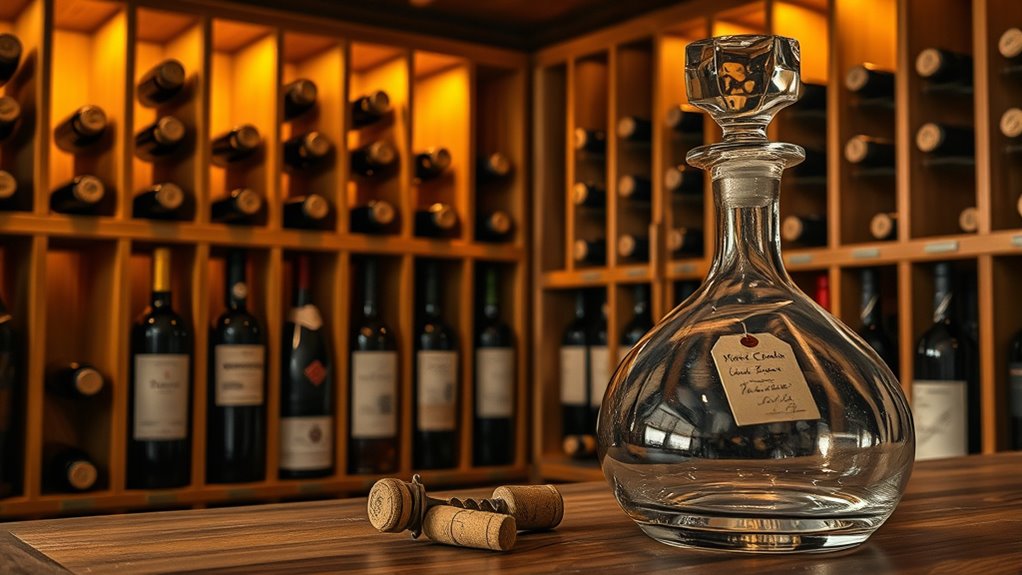
How can you confidently navigate the wine market and verify provenance? Start by following reputable auction houses like Sotheby’s, Christie’s, Bonhams, and Zachys. These institutions rigorously authenticate wine authenticity and provide detailed provenance, including ownership history, photographs, and documentation. Always investigate a wine’s provenance thoroughly before bidding, especially if it has traveled extensively or lacks clear records. Building relationships with fine wine experts at these auction houses can help you understand bidding strategies and spot authentic, well-stored bottles. Be cautious of wines with uncertain provenance, as they can impact value and authenticity. Ensure that wines are stored properly and transferred in your name before purchase. These steps help protect your investment and maintain your collection’s integrity.
Investing in Fine Wines and Managing Risks
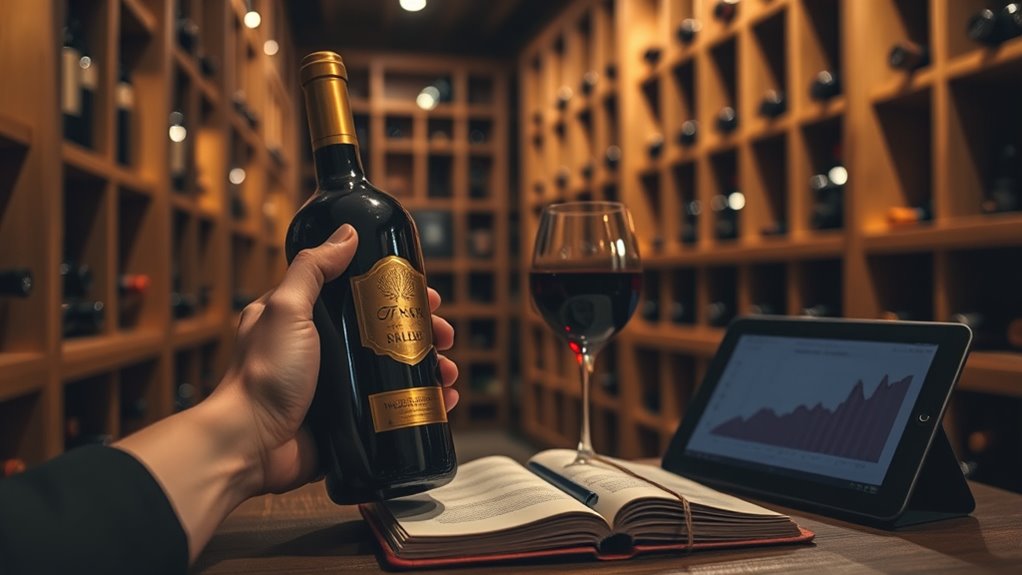
Investing in fine wines can be a lucrative venture if you understand the key factors that influence their value and how to manage associated risks. To succeed, focus on high-quality wines like Bordeaux and Burgundy, such as Pétrus and Domaine de la Romanée-Conti, which often appreciate over time. Keep in mind that investing in fine wines usually requires a minimum spend of around £200 per bottle under bond to maximize potential gains. Proper storage in sealed, temperature-controlled environments and professional ‘under bond’ facilities are essential for preserving your wine collection’s value. Provenance matters too; buy from reputable auction houses like Sotheby’s or Christie’s to reduce counterfeit risks and boost resale prospects. Ultimately, stay aware of market fluctuations, exchange rates, and geopolitical events that can impact your investment returns.
Selling and Liquidating Your Collection
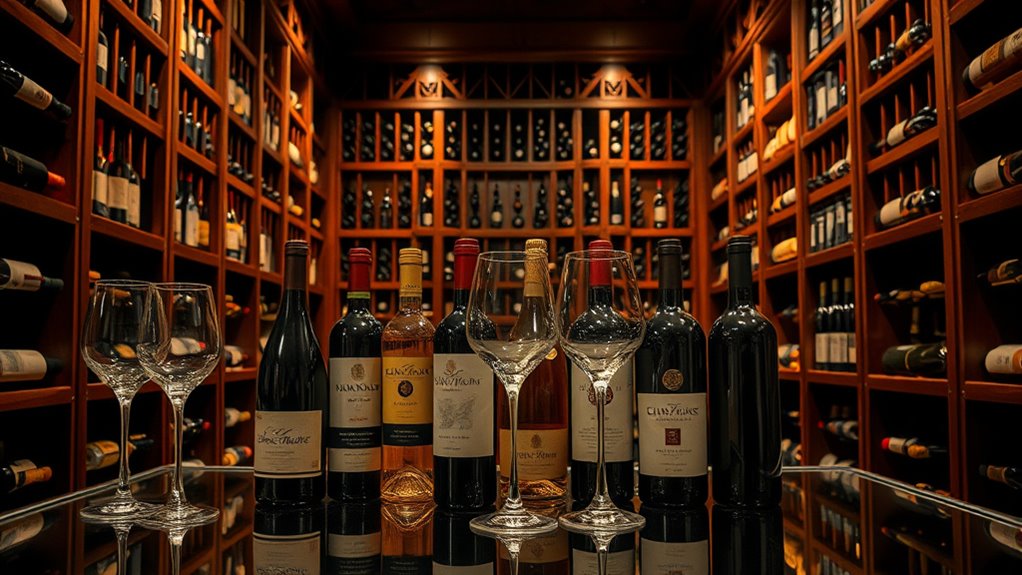
When it’s time to sell or liquidate your wine collection, strategic planning can make a notable difference in maximizing your returns. Proper organization and documentation of your wine inventory streamline the selling process and help you secure better prices. Partnering with reputable auction houses like Sotheby’s, Christie’s, or Zachys opens access to a global market and ensures authentic provenance, boosting buyer confidence. Timing is critical; selling older or rare wines when market demand peaks can considerably increase your profits. Professional brokers or wine merchants offer expert guidance on pricing, marketing, and choosing the best sales channels for your collection. Maintaining good provenance and storage conditions further enhances buyer trust and minimizes the risk of undervaluation or rejected wines during the liquidation process.
Enhancing Your Experience With Food Pairings

Once you’ve organized and preserved your wine collection, enhancing your tasting experience through thoughtful food pairings can elevate every sip. When selecting food pairings, consider the wine’s flavor profile and the occasion.
- Pair full-bodied reds like Cabernet Sauvignon or Syrah with rich meats and aged cheeses to complement their tannic structure and intense flavors.
- Match light whites such as Sauvignon Blanc or Pinot Grigio with fresh seafood, salads, or light poultry to highlight their citrus and herbal notes.
- Use sparkling wines like Champagne or Prosecco for salty appetizers, fried foods, or spicy dishes to balance acidity and bubbles.
Understanding how storing wine affects its development helps you choose the perfect pairings, making your wine collection even more enjoyable.
Frequently Asked Questions
What Is the Art of Wine Making Called?
The art of wine making is called enology, which combines science and craftsmanship. When you get involved in wine production, you explore viticulture, fermentation, aging, blending, and bottling. Skilled winemakers use sensory evaluation, climate knowledge, and technical skills to create high-quality wines. If you’re studying this field, enology programs help you learn both the scientific and artistic sides of turning grapes into the wine you enjoy.
What Is a Collector of Wine Called?
Did you know that over 1.4 billion liters of wine are produced worldwide annually? A person who collects wine is typically called a “wine collector” or “oenophile.” You might also be called a “wine connoisseur” if you deeply appreciate and understand wine. These terms describe someone dedicated to curating and enjoying a personal wine collection, whether for passion or investment. Your love for wine makes you part of this fascinating world.
How Profitable Is Wine Collecting?
You wonder how profitable wine collecting is. It can be lucrative if you buy top wines like Bordeaux or Burgundy, hold them for 5-10 years, and sell when market conditions favor. However, profits aren’t guaranteed because market fluctuations, storage issues, and demand shifts can impact your returns. With expertise and strategic choices, you might see good gains, but always remember the risks involved.
What Are the Four C’s of Wine?
You want to know the four C’s of wine. They help you assess quality: Color shows age and grape type; Cork is crucial for preservation, preventing spoilage; Clarity indicates if the wine’s clear and stable; and Condition reflects the wine’s overall state, aroma, and flavor. By examining these factors, you can gauge a wine’s quality and determine if it’s ready to enjoy or suitable for aging.
Conclusion
As you craft your wine collection, think of it as tending a vibrant garden—each bottle a unique blossom waiting to be nurtured. With passion and patience, your collection will flourish, revealing new depths and flavors. Trust your palate, stay curious, and let your love for wine be the guiding star. Soon, your cellar will be a symphony of stories and senses, a masterpiece that’s uniquely yours to savor and share.
